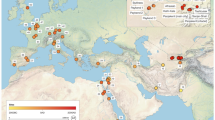Abstract
POLAR BEARS (Thalarctos maritimus) normally have creamy-white fur, presumably an adaptation for camouflage in a snowy environment. However, during the summer of 1978, the fur on the back and sides of three adults in the San Diego Zoo turned green, though the animals remained otherwise healthy. (Of these bears, one female was born in the zoo in Calgary, Alberta, Canada, in 1966 and was transferred to the San Diego Zoo in 1969; a second female was born in the wild, having been caught at Spitzbergen in 1951; the third, a male, was born in the San Diego Zoo in 1970.) This phenomenon, though less marked, has been noted in several previous summers, both here and in zoos elsewhere, for example, in Cologne, Germany (C. Hill, personal communication). The coloration was particularly evident on the flanks, on the outer fur of the legs and in a band across the rump: fur on the head and belly and inner sides of the legs was white. We first supposed that the colour was due to green algae such as Chlorella or Scenedesmus on the surfaces of hairs, growth of such algae being promoted by the presence of nitrogenous wastes in the waters of the bears' pool. (The pool in the exhibit area, which contains 12,500 gallons of tap water, is drained and cleaned twice weekly.) However, microscopic examination of samples of hair taken from the three San Diego bears and from a similarly green polar bear in the zoo at Fresno, California, revealed that this was not so. The outer surfaces of the hairs appeared clean and smooth, except for the normal squamation. The coloration was clearly attributable to the presence of algae inside the hairs, specifically in the hollow medullae of many of the wider (50–200 µm), stiffer guard hairs of the outer coat. (The thinner (<20 µm) and more undulant hairs of the under coat, which were not hollow, were colourless.) Some of the lumina were apparently filled with air, but many of these hollow spaces were partly occupied by masses of small greenish cells, which we describe here.
This is a preview of subscription content, access via your institution
Access options
Subscribe to this journal
Receive 51 print issues and online access
$199.00 per year
only $3.90 per issue
Buy this article
- Purchase on Springer Link
- Instant access to full article PDF
Prices may be subject to local taxes which are calculated during checkout
Similar content being viewed by others
References
Wildman, A. B., The Microscopy of Animal Textile Fibres (Wool Industries Research Association, Leeds, 1954).
Maertens, H. Beitr. Biol. Pfl. 12, 439–496 (1914).
Lewin, R. A. & Cheng, L. Phycologia 14, 149–152 (1975).
Edgren, R. A., Edgren, M. K. & Tiffany, L. H. Ecology 34, 733–740 (1953).
Johnson, B. W. & Johnson, P. A. US Mammal Commission Rep. MMC-77/05 (Washington, DC, 1978).
Scheffer, V. B. Pelage and surface topography of the northern fur seal. North American Fauna No. 64 (1961).
Weber van Bosse, A., Natuurk. Verh. ser 3, 5, 1–23 (1903).
Sanderson, I. T. The Monkey Kingdom: Introduction to the Primates, 19 (Hanover House, New York, 1957).
Nemoto, T. Whales Res. Inst. (Tokyo), Sci. Rep. 11, 99–132 (1956).
Author information
Authors and Affiliations
Rights and permissions
About this article
Cite this article
LEWIN, R., ROBINSON, P. The greening of polar bears in zoos. Nature 278, 445–447 (1979). https://doi.org/10.1038/278445a0
Received:
Accepted:
Issue Date:
DOI: https://doi.org/10.1038/278445a0
This article is cited by
-
Symbioses between salamander embryos and green algae
Symbiosis (2011)
-
Algae of terrestrial habitats
The Botanical Review (1989)
Comments
By submitting a comment you agree to abide by our Terms and Community Guidelines. If you find something abusive or that does not comply with our terms or guidelines please flag it as inappropriate.



